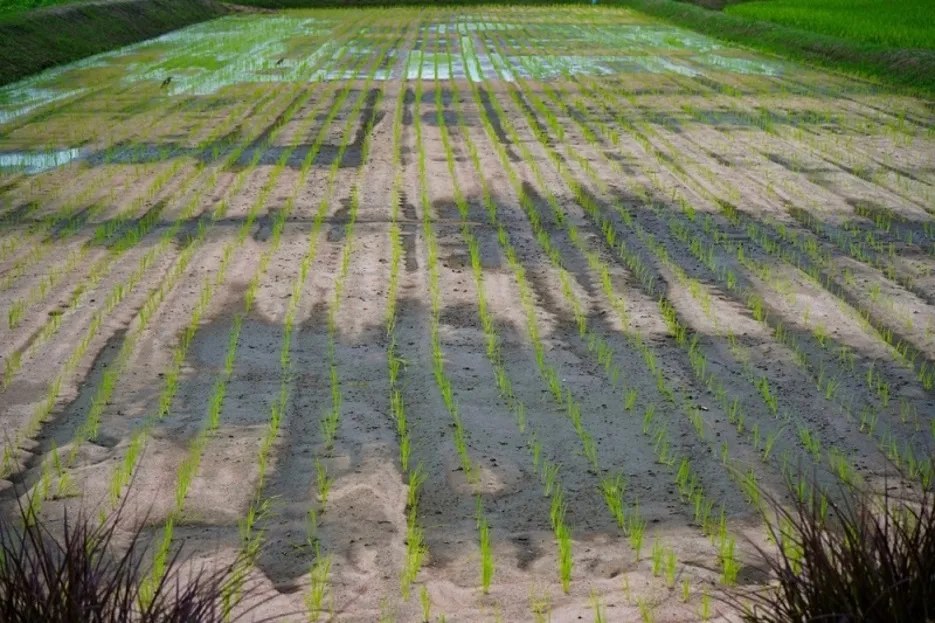 ਵਾਪਸ
ਵਾਪਸ

Direct Seeded Rice is getting popular in many areas of India . We are giving important practices of land preparation and early crop establishment for benefit of farmers below.
Sowing Window
Sowing Window
• For Kharif season sowing should be done immediately after the onset of the monsoon during the month of June to July. • For Rabi season sowing is done from November - December.
Sowing Method
Sowing Method
There are four types of sowing methods in DSR: A) Wet DSR : Laichopi B) Dry DSR: Sowing with Tractor Drawn Seed Drill (Tar Vattar) C) Dry DSR: Botta D) Dry DSR: Khurra
DSR Wet sowing
DSR Wet sowing
• The land is ploughed sufficiently, puddle and level the field before sowing • Prior to sowing, level the field once again by incorporating the basal dose of fertilizer (10% N: 100% P2O5: 75% K2O) recommended • Drain out the water from the fields and then broadcast / line sown the seeds uniformly with pregerminated seeds


Sowing with Tractor Drawn Seed Drill (Tar - Vattar)
Sowing with Tractor Drawn Seed Drill (Tar - Vattar)
• Do 2-3 ploughings (Harrowing) for field preparation after harvest of previous crop • Apply heavy pre-sowing irrigation • Do one light ploughing when soil reaches to field capacity follow up with a planking and laser levelling • Mix 10 kg hybrid seed + 30 kg DAP and sow the seeds with Tractor Drawn Seed Drill at 60-70% soil moisture, similar to wheat. • Seeds get automatically covered after sowing • Optimum germination can be seen in rows after 5-7 days.


Dry DSR: Botta
Dry DSR: Botta
• The land is ploughed sufficiently during summer to get the good tilth Level the field before the season by removing all the weeds • After the onset of the Monsoon field will be ploughed finally and seeds will be sown. • Seed is sown by way of broadcasting/seed drill when soil moisture is 60 – 70 %. • Cover the Seeds by harrowing to avoid bird’s damage and proper germination.


Dry DSR: Khurra
Dry DSR: Khurra
• Prepare the fields before the onset of the Monsoon. • Seed is sown in dry soil, 15 days before the onset of Monsoons. • Cover the Seeds by harrowing to avoid bird damage and proper germination. • In this method, hybrid cultivars are not recommended.


Weed Management
Weed Management
Inter-cultivation is helpful for weed management and also to loosen the soil for better root development. Weeding should be done from the initial tillering to the maximum tillering stage. Weeding is done by 3 methods: A) Hand/ Manual weeding B) By machine: Use manual or machine-operated Cono-Weeder for effective weed control. C) By chemical. Apply recommended weedicides. • Apply one preemergent herbicide pendimethalin/pretilachlor @ 0-3 days after sowing • Apply COUNCIL active as early post-emergence herbicide at 8 - 15 days after sowing when the weeds are at 1 – 3 leaf stage, at the dose of 90 g per acre with 150 liters of water as a spray.• It helps in controlling broadleaf, grassy weeds, and managing sedges. • For the escaped weeds apply another round of herbicide based on the type of weeds.


Micronutrient Application
Micronutrient Application
Zinc: Symptoms: • Rice: Appearance of rusty-brown spots and discoloration of older leaves beginning 2-3 weeks after transplanting is noticed. Under acute conditions, leaf margins of older leaves dry up. New leaves are smaller in size. Crop maturity is non-uniform and delayed. • If Zinc deficiency symptoms appear go for minimum of 2 foliar sprays of Zinc Sulphate @ 0.5 % solution.


Iron: Symptoms: • Interveinal chlorosis in streaks is noticed. Drying of leaves starts from tips and margins. Under severe conditions, leaves become white and die. • If Iron deficiency symptoms appear in the main crop go for foliar spray of Ferrous Sulphate at 1% around 2-3 sprays till the leaves color turned into normal green.


Thank you for reading this article, we hope you clicked on the ♡ icon to like the article and also do share it with your friends and family now!








